Public art and history: Silver Spring’s Memory Wall
25 May 2017 – David Rotenstein
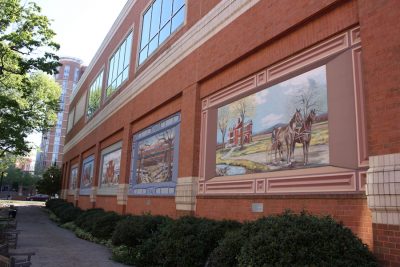
The Silver Spring Memory Wall was completed on the exterior wall of a Caldor department store. Photo credit: David Rotenstein.
In the 1990s, Silver Spring, Maryland, was desperate for economic investment and an image makeover. Next door to Washington, D.C., the Montgomery County suburb had suffered from two decades of disinvestment and white flight. Once a thriving community with a booming commercial district and sprawling inner-ring suburban neighborhoods, Silver Spring had become blighted by vacant storefronts and empty parking lots. In their efforts to revive and rebrand the municipality’s struggling central business district, Silver Spring’s boosters ignored troubling racial dynamics in producing an imaginary depiction of the community’s history.
One of the earliest attempts at remaking Silver Spring began in 1994 and it included a public art and placemaking project that used images drawn from the community’s past. Conceived as an amenity to allow a developer to exceed land use limitations for a proposed department store, the “Silver Spring Memory Wall” included five murals depicting Silver Spring during critical points in the community’s history. Arranged chronologically, the murals show Silver Spring’s antebellum rural origins, the Civil War, the armory illustrating early community life, the old Baltimore & Ohio Railroad train station during the interwar years, and an Art Deco movie theater and shopping center depicting Silver Spring’s commercial boom period.
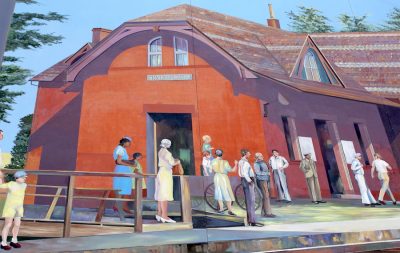
Detail from the mural depicting passengers awaiting the arrival of the Baltimore & Ohio Railroad train at the Silver Spring station between the world wars. Photo credit: David Rotenstein.
Although the murals were loosely based on historic photographs, the train station scene portrays something that could never have occurred in the years between World War I and World War II: African Americans standing side by side with whites waiting for an arriving train. That mixed-race use of space would have been unthinkable before the mid-1960s.
Silver Spring is a former sundown suburb, a place where African Americans could not live. Prior to 1948, most of Silver Spring—more than 10 square miles—included residential subdivisions where developers and individual property owners prohibited African Americans from buying, renting, or otherwise occupying properties. The only exceptions were for domestic servants living with their white employers. After the Supreme Court ruled racial restrictive covenants unenforceable in the 1948 case, Shelley v. Kraemer, housing discrimination persisted by way of redlining, steering, and so-called “gentleman’s agreements” among realtors to not show properties to prospective African American home buyers. Apartment building owners openly discriminated against African American renters. Silver Spring became the first stop for whites fleeing Washington’s neighborhoods where African Americans had begun buying homes. A generation later, as civil rights laws and court decisions removed barriers to racial discrimination in the suburbs, Washington’s African Americans followed their former white neighbors into the suburbs.
In Silver Spring’s businesses, Jim Crow segregation remained the rule until the early 1960s. After multiple surveys by the NAACP documented discrimination in restaurants and after the Department of Labor moved 600 office workers (including about 200 African Americans) from the District of Columbia to office buildings in Silver Spring, Montgomery County enacted an open accommodations law [PDF] in 1962, prohibiting discrimination based on race in the county’s licensed businesses. It took another five years before the county passed an open housing law. Before these laws, African Americans who lived in lower Montgomery County could not attend movies in Silver Spring’s two movie theaters, eat in most of the community’s restaurants, attend dances and other civic celebrations at Silver Spring’s armory, or shop freely in the locally-owned and regional department stores doing business there.
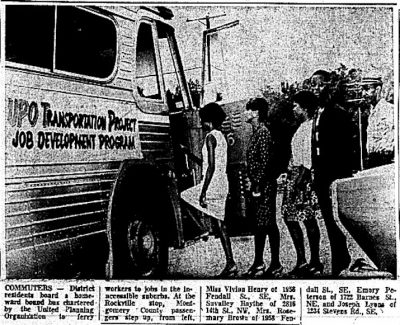
African American residents of Washington board a bus that allowed them to get from their homes in the District of Columbia to jobs in Silver Spring and elsewhere in Montgomery County. Image credit: The Washington Afro-American, September 3, 1966.
Silver Spring’s racialized residential, commercial, and civic life imposed social costs well beyond Montgomery County’s border with the District of Columbia. As federal agencies dispersed their integrated workforces into the suburbs during the Cold War, managers struggled to find ways to get African American employees from their homes in Washington to Silver Spring. in the early 1960s, the United Planning Organization, Washington’s federally designated anti-poverty organization, began offering bus service from the city’s African American neighborhoods to Silver Spring.
Much of Silver Spring’s white supremacist past has been erased by community branding efforts and it has been omitted by official histories produced by Montgomery County’s historic preservation office. Likewise, many academic historians researching housing, businesses, and commercial architecture have omitted the African American experience from their studies of Silver Spring.
Within this context of structural and institutional racism that defines Silver Spring’s past, community leaders embarked in the 1990s on a campaign to restore Silver Spring to its mid-twentieth century heyday as a thriving place for businesses and residents. The Silver Spring Memory Wall was created, in part, to proclaim that Silver Spring was alive and again open for business. Mame Cohalan, an acclaimed Washington mural artist, was contracted to paint five panels “depicting historical images or moments from Silver Spring’s past,” wrote local planning officials in 1994. The Maryland-National Capital Planning Commission and a Silver Spring art advisory group had control over the mural’s contents and the property owner granted a perpetual easement to Montgomery County for “periodic maintenance.”
Cohalan recalls working with an engaged community eager to celebrate Silver Spring’s history while also cultivating a carefully crafted image. In a recent telephone interview, she described the Memory Wall project as a marketing campaign for Silver Spring: a branding tool for the community that by the 1990s had become increasingly ethnically diverse. By the turn of the twenty-first century, Silver Spring had a growing African American population and a substantial immigrant community with Latinos and a large enough Ethiopian population to be dubbed Washington’s “Little Ethiopia.” To look at Silver Spring today and the many representations of Silver Spring’s past, it would be easy for a newcomer to assume that the community had always been diverse and that it had never excluded people of color. Public art like the Silver Spring Memory Wall reinforce that false sense of history.
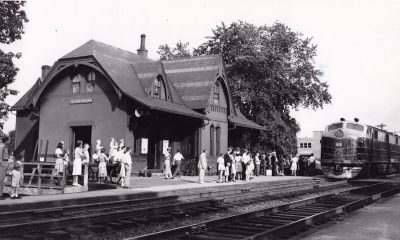
Silver Spring Rail Road Station, c. 1941. Photo credit: Montgomery County Historical Society.
In our conversation, Cohalan explained to me how she used photographs as the basis for the three scenes depicting Silver Spring in the twentieth century. And then she added some artistic license. “I felt that at a train station there should be some diversity because everybody takes a train,” she said. “There was just a little part of my doing, my participation in this, where I knew I was manipulating, sticking myself and my opinions into the picture.” Cohalan acknowledged that she was unaware of Silver Spring’s racialized history when she designed the murals. After I explained some of Silver Spring’s segregationist history, Cohalan admitted, “I probably sensed that.”
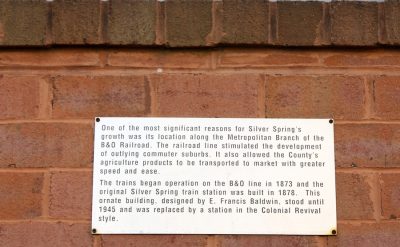
Text panel beneath the mural depicting Silver Spring’s Baltimore & Ohio train station. Photo credit: David Rotenstein.
We spoke for a little while longer about whether the murals were history, art, or somewhere in-between. Cohalan conceded that they probably occupied a middle-ground between history and whimsy. And then she suggested a solution to dissonance her historical images of Silver Spring create with Silver Spring’s past: “You’re welcome to put an asterisk that says the artist—well, I don’t know what the words would be—decided to edit history a little bit here.”
The Silver Spring Memory Wall opens up opportunities to examine how a community produces history in public spaces. The murals are part history lesson and part branding exercise. An important weakness in such productions is the creation of a misleading sense of history—in Silver Spring’s case, a false image of historical diversity. In my conversation with the artist, it was she who arrived at a possible solution: better contextualization by revising text panels placed beneath the murals. For public historians, this case is an opportunity to expand our understanding of the roles murals play mediating history and economic development.
~ David Rotenstein is a consulting historian based in Silver Spring, Maryland. He researches and writes on historic preservation, industrial history, and gentrification.




Where is the mural located?